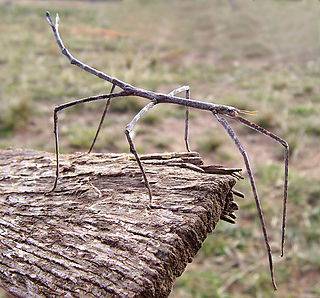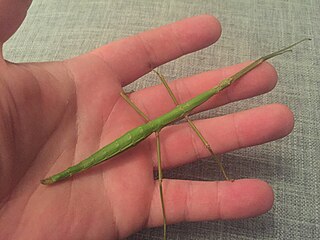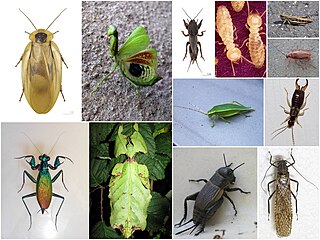
Entomology is the scientific study of insects, a branch of zoology. In the past the term "insect" was less specific, and historically the definition of entomology would also include the study of animals in other arthropod groups, such as arachnids, myriapods, and crustaceans. This wider meaning may still be encountered in informal use.

The Phasmatodea are an order of insects whose members are variously known as stick insects, stick-bugs, walking sticks, or bug sticks. They are generally referred to as phasmatodeans, phasmids, or ghost insects. Phasmids in the family Phylliidae are called leaf insects, leaf-bugs, walking leaves, or bug leaves. The group's name is derived from the Ancient Greek φάσμα phasma, meaning an apparition or phantom, referring to their resemblance to vegetation while in fact being animals. Their natural camouflage makes them difficult for predators to detect; still, many species have one of several secondary lines of defence in the form of startle displays, spines or toxic secretions. Stick insects from the genera Phryganistria, Ctenomorpha, and Phobaeticus includes the world's longest insects.

Timema is a genus of relatively short-bodied, stout stick insects native to the far western United States, and the sole extant member of the family Timematidae. The genus was first described in 1895 by Samuel Hubbard Scudder, based on observations of the species Timema californicum.

Argosarchus is a monotypic genus in the family Phasmatidae containing the single species Argosarchus horridus, or the New Zealand bristly stick insect, a stick insect endemic to New Zealand. The name "horridus" means bristly in Latin, likely referring to its spiny thorax.

The Phasmatidae are a family of the stick insects. They belong to the superfamily Anareolatae of suborder Verophasmatodea.

The Phasmatinae are a subfamily of stick insects in the family Phasmatidae. They contain at least three tribes; Bradley and Galil corrected the spelling to "Phasmatinae" and provides a key to tribes.

Ctenomorpha marginipennis, the margin-winged stick insect, is a species of stick insect endemic to southern Australia. The species was first described by George Robert Gray in 1833.

Dryococelus australis, commonly known as the Lord Howe Island stick insect or tree lobster, is a species of stick insect that lives on the Lord Howe Island Group. It is the only member of the monotypic genus Dryococelus and was thought to be extinct by 1920, only to be rediscovered in 2001. It is extirpated in its largest former habitat, Lord Howe Island, and has been called "the rarest insect in the world", as the rediscovered population consisted of 24 individuals living on the small islet of Ball's Pyramid.

Clitarchus hookeri, is a stick insect of the family Phasmatidae, endemic to New Zealand. It is possibly New Zealand's most common stick insect. Clitarchus hookeri is often green in appearance, but can also be brown or red. Alongside the prickly stick insect and the Unarmed stick insect, C. hookeri is one of three stick insect species to have become naturalised in Great Britain, with all three having originated in New Zealand.

Acanthoxyla prasina, the prickly stick insect, is a stick insect in the order Phasmatodea and the family Phasmatidae. It is found throughout New Zealand, although it is less frequently reported than "common" stick insect species. It has been introduced to Britain, predominately Cornwall and Devon, and to the south-west region of the Republic of Ireland. It has a thorny skin, which is used as camouflage.

Acanthoxyla is a genus of stick insects in the family Phasmatidae. All the individuals of the species are female and reproduce asexually by parthenogenesis. However, a male Acanthoxyla inermis was recently discovered in the UK, probably the result of chromosome loss. The genus is the result of interspecific hybridisation resulting in some triploid lineages and some diploid lineages. The genus is endemic to New Zealand, but some species have been accidentally introduced elsewhere. The genus name Acanthoxyla translates from Greek as prickly stick.

Acanthoxyla inermis is an insect that was described by John Tenison Salmon 1955. Acanthoxyla inermis is included in the genus Acanthoxyla, and family Phasmatidae. No subspecies are listed. This species is native to New Zealand but has been unintentionally moved to Great Britain where it has grown a stable population and is the longest insect observed, and the most common of the stick insects that have established themselves on the island.
Clitarchus rakauwhakanekeneke is a stick insect that belongs the common New Zealand genus Clitarchus. It lives only on the Poor Knights Islands.
Clitarchus tepaki is a stick insect that belongs to the common New Zealand genus Clitarchus. It is endemic to the North Cape area of New Zealand, in particular Te Paki and the Karikari Peninsula.
Tepakiphasma ngatikuri is a stick insect of the family Phasmatidae, endemic to a single patch of forest near the northernmost tip of the North Island, New Zealand. It was not discovered until 2008, and is the only member of the genus Tepakiphasma.

The cohort Polyneoptera is a proposed taxonomic ranking for the Orthoptera and all other Neopteran insects believed to be more closely related to Orthoptera than to any other insect orders. These winged insects, now in the Paraneoptera, were formerly grouped as the Hemimetabola or Exopterygota on the grounds that they have no metamorphosis, the wings gradually developing externally throughout the nymphal stages.

Spinotectarchus acornutus is a species of stick insect endemic to New Zealand. It belongs to the family Diapheromeridae, and is the only member of the genus Spinotectarchus. It is commonly referred to as the spiny ridge-backed stick insect.

Orestes shirakii is a species of stick insects native to Taiwan.














